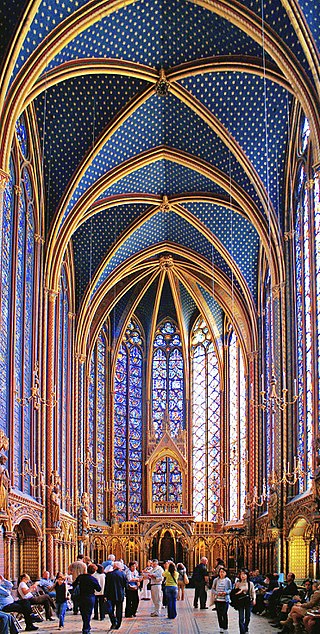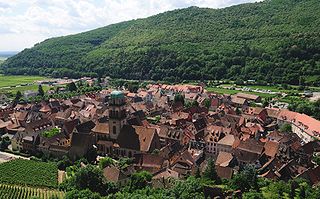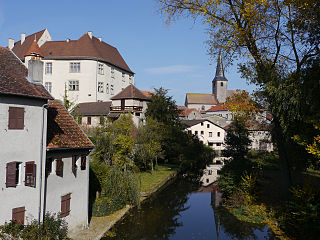
The Sainte-Chapelle is a royal chapel in the Gothic style, within the medieval Palais de la Cité, the residence of the Kings of France until the 14th century, on the Île de la Cité in the River Seine in Paris, France.

The Château d'Angers is a castle in the city of Angers in the Loire Valley, in the département of Maine-et-Loire, in France. Founded in the 9th century by the Counts of Anjou, it was expanded to its current size in the 13th century. It is located overhanging the river Maine. It is a listed historical monument since 1875. Now open to the public, the Château d'Angers is home of the Apocalypse Tapestry.

The Château de Vincennes is a former fortress and royal residence next to the town of Vincennes, on the eastern edge of Paris, alongside the Bois de Vincennes. It was largely built between 1361 and 1369, and was a preferred residence, after the Palais de la Cité, of French Kings in the 14th to 16th century. It is particularly known for its "donjon" or keep, a fortified central tower, the tallest in Europe, built in the 14th century, and for the chapel, Sainte-Chapelle de Vincennes, begun in 1379 but not completed until 1552, which is an exceptional example of Flamboyant Gothic architecture. Because of its fortifications, the château was often used as a royal sanctuary in times of trouble, and later as a prison and military headquarters. The chapel was listed as an historic monument in 1853, and the keep was listed in 1913. Most of the building is now open to the public.

Kaysersberg is a historical town and former commune in Alsace in northeastern France. The name is German for Emperor's Mountain. The high fortress that dominates the town serves as a reminder of both its strategic importance and its warlike past.

Flamboyant is a form of late Gothic architecture that developed in Europe in the Late Middle Ages and Renaissance, from around 1375 to the mid-16th century. In the French timetable of styles, as defined by French scholars, it is the fourth phase of Gothic style, preceded by Primary Gothic, Classic Gothic and Rayonnant Gothic.

Luz-Saint-Sauveur is a commune in the Hautes-Pyrénées department in the Occitania region of south-western France. It lies on the river Bastan, a tributary of the Gave de Pau. Locals simply call it Luz, the city took its current name from Luz-Saint-Sauveur on April 9, 1962. Its inhabitants are called Luzéens and Luzéennes in French. The town features locations of historical heritage such as the church of Saint-André, also known as "Les Templiers", the Château Sainte-Marie or the spa district. Protected by mountains to the east, west and south, and separated from the plain to the north by the Pierrefitte gorge, Luz-Saint-Sauveur is somewhat geographically isolated though it is only a 1⁄2 hour drive from Lourdes.

Beaumont-de-Pertuis is a commune in the Vaucluse department in the Provence-Alpes-Côte d'Azur region in southeastern France.

The Château de Châteaudun is a castle located in the town of Châteaudun in the French department of Eure-et-Loir.

French Gothic architecture is an architectural style which emerged in France in 1140, and was dominant until the mid-16th century. The most notable examples are the great Gothic cathedrals of France, including Notre-Dame Cathedral, Reims Cathedral, Chartres Cathedral, and Amiens Cathedral. Its main characteristics are verticality, or height, and the innovative use of the rib vault and flying buttresses and other architectural innovations to distribute the weight of the stone structures to supports on the outside, allowing unprecedented height and volume. The new techniques also permitted the addition of larger windows, including enormous stained glass windows, which fill the cathedrals with light.

Fénétrange is a commune in the Moselle department in Grand Est in north-eastern France.

Saint-Maime is a commune in the Alpes-de-Haute-Provence department in southeastern France. It is located in the Luberon national park and is home to the 12th century chapel Chapelle Sainte-Agathe.

Montmeyan is a commune (municipality), located in the department of Var, in the region of Provence-Alpes-Côte d'Azur, southeastern France.
There are numerous castles in the Gersdépartement of France. Many are little more than ruins and some are barely discernible, while others have been converted into modern homes. Castles or their remains may be found at the following locations, among others:

The Château de Ners is a ruined castle standing on a hill dominating the valley of the Pichauris. It is located north east of the town of Allauch in the commune of Allauch in the Bouches-du-Rhône département of France.

The Sainte-Chapelle de Vincennes is a Gothic royal chapel within the fortifications of the Château de Vincennes on the east edge of Paris, France. It was inspired by the Sainte-Chapelle, the royal chapel within the Palais de la Cité in Paris. It was begun in 1379 by Charles V of France to house relics of the Passion of Christ. It is no longer used as a church, and is now a French historical monument operated by the Centre des monuments nationaux.

The Château de Châtillon-d'Azergues is a ruined castle in the commune of Châtillon in the Rhône département of France.

Putanges-le-Lac is a commune in the department of Orne, northwestern France. The municipality was established on 1 January 2016 by merger of the former communes of Chênedouit, La Forêt-Auvray, La Fresnaye-au-Sauvage, Ménil-Jean, Putanges-Pont-Écrepin, Rabodanges, Les Rotours, Saint-Aubert-sur-Orne and Sainte-Croix-sur-Orne.
Gouffern en Auge is a commune in the department of Orne, northwestern France. The municipality was established on 1 January 2017 by merger of the former communes of Silly-en-Gouffern, Aubry-en-Exmes, Avernes-sous-Exmes, Le Bourg-Saint-Léonard, Chambois, La Cochère, Courménil, Exmes, Fel, Omméel, Saint-Pierre-la-Rivière, Survie, Urou-et-Crennes and Villebadin.

The Keep of Pons is an 830-year-old fortified tower located in Pons, France and is one of the few remnants of the original castle of Pons. The keep is located near the chapel and porch of Saint Gilles and remains of the ramparts. On a hill and visible from a distance, this 33-meter-high (108 ft) edifice is used as the symbol of the city.

The Château de Chalencon is a feudal monument situated in the hamlet of Chalencon, about 1 kilometre north east of the village of Saint-André-de-Chalencon, in the Haute-Loire département, in the Auvergne-Rhône-Alpes region of France.



















